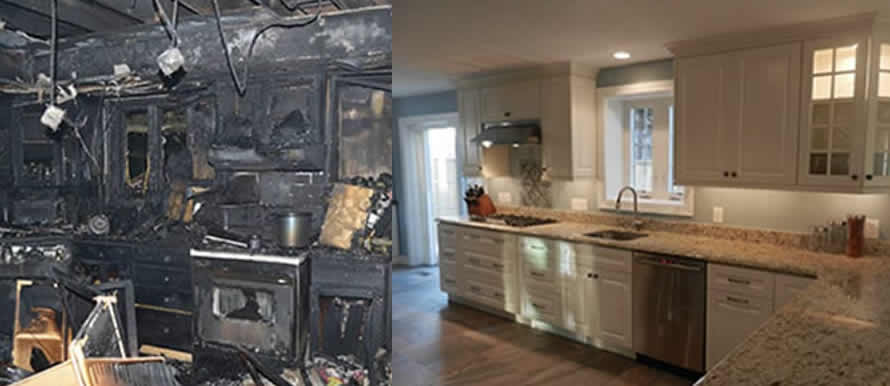FIRE DAMAGE RESTORATION
Fire Damage Restoration
We treat all fires as emergencies and move as quickly as possible to limit damage to your property and belongings.
Whether it’s your home or a business, an unexpected fire is devastating. The shock of losing your personal property or inventory is followed by the stress of having to quickly make emergency decisions. It can feel completely overwhelming!
Although we hope that a fire is not something you ever have to experience, Blue Star Restoration has stood by the side of many clients over the years and helped them though the fire restoration process. If the worst happens and you do suffer from fire loss, we will be here for you too!
Unfortunately, unlike water damage which can be mitigated in a matter of days to a couple of weeks, fire damage clean-up and restoration can take weeks to months depending on the amount of damage. In addition, fire damage is often times accompanied with water damage as the fire department works to extinguish the flames and/or water pipes burst from the heat. Since standing water also causes tremendous structural damage, the first important step we take is to mitigate any water damage even before we inspect the fire damage. By using this procedure, we prevent further structural damage from occurring.
Types of Fire Damage
Class “A” Fire Damage
Class A fires are fueled by flammable solids, aka ordinary combustible materials. Embers are started by plastics, paper, rubber, wood, or cloth which leave ash behind. These blazes are often extinguished by water or other extinguishing agents.
Class “B” Fire Damage
Class B fires are fueled by high-hazard flammable liquids, combustible liquids, or solids that can be liquefied. Gases, solvents, petroleum, tars, oil-based paints, alcohols, lacquers, and solvents are usually involved. Foam extinguishing agents commonly extinguish these blazes.
Class “C” Fire Damage
Class C fires are fueled by flammable solids or liquids that would regularly be considered class A or B, except for the addition of energized electrical equipment. These blazes are often extinguished by carbon dioxide or dry chemicals to reduce the chance of electrocution.
Class “D” Fire Damage
A combination of combustible metals fuel class D fires, these metals can include magnesium, sodium, lithium, potassium, titanium, or zirconium. Blazes are extinguished by specialized powders, sodium chloride, or sand because water can break into explosive hydrogen and oxygen by extremely high-temperature flames.
Class “E” Fire Damage
Class E fires are fueled by flammable solids or liquids that would regularly be considered class A or B, except for the addition of energized electrical equipment. These would include sparks started by faulty wiring, worn-out home appliances, and improper electrical outlet use.
Class “F” Fire Damage
Class F fires are fueled by combustible cooking oils or fats. These are typically kitchen-related. They are very destructive and burn hotter than class B flammable liquids.
Our Process
Assess
After making sure your property is safe to enter, our contractor will do an initial assessment of how much fire and water damage has occurred and how extensive clean-up will be. This assessment will include what personal property and/or inventory can be saved and what must be discarded. This information is crucial for developing an accurate time and cost estimate.
Secure
The next step after assessing damage is to secure the property. This may include boarding up windows and doors, installing temporary fencing, and installing tarps on the roof when necessary to prevent further weather damage. Fire debris is removed from around your home or business. Damaged areas will be sealed off from undamaged areas to prevent cross contamination.
Demo/Dry Out
It is important to move quickly to dry out your property before mold can settle in, causing even more damage to the structure. Personal property is removed from the impacted areas and damaged drywall, ceilings, flooring, and other effected materials removed. Commerical grade equipment is then used to remove any standing water and dry out the structure.
Smoke Removal & Clean-Up
The most rigorous part of fire damage repair is the clean-up stage. It is labor intense and not unusual for every square inch of a damaged space to need scrubbing and cleaning. In addition, we apply deodorizing agents to completely remove any lingering smoke smells. If mold remediation has been performed, the area may also require the application of biocides to prevent mold from returning.
Construction/Restoration
It’s finally time to restore your property to its original condition! Depending on the level of fire damage and how much of the structure had to be removed, this may involve replacing the roof, electrical wiring, drywall, flooring, ceiling, counter tops, fixtures, and repainting the interior. We stay in contact with you throughout the entire process to keep you updated on timelines and ensure your satisfaction.

